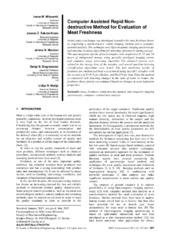Приказ основних података о документу
Kompjuterski potpomognuta, brza, nedestruktivna metoda za evaluaciju svežine mesa
Computer assisted rapid nondestructive method for evaluation of meat freshness
| dc.creator | Mileusnić, Ivana | |
| dc.creator | Šakota-Rosić, Jovana | |
| dc.creator | Munćan, Jelena S. | |
| dc.creator | Dogramadzi, Sanja B. | |
| dc.creator | Matija, Lidija | |
| dc.date.accessioned | 2022-09-19T18:15:37Z | |
| dc.date.available | 2022-09-19T18:15:37Z | |
| dc.date.issued | 2017 | |
| dc.identifier.issn | 1451-2092 | |
| dc.identifier.uri | https://machinery.mas.bg.ac.rs/handle/123456789/2647 | |
| dc.description.abstract | U ovom istraživanju je za procenu svežine mesa razvijena tehnika koja koristi nedestruktivnu metodu na bazi optičke slike i kompjuterski potpomognutu analizu. Tehnika podrazumeva kombinovanje Opto-magnetne imidžing spektro- skopije i algoritama mašinskog učenja kako bi se utvrdila svežina mesa, odnosno vreme skladištenja. Akvizicija Opto-magnetnih spektara uzoraka mesa, čuvanih u frižideru za vreme trajanja eksperimenta, rađena je nakon 0h, 12h i 24h skladištenja i to specijalno razvijenim imidžing sistemom, podržanim odgovarajućim kompjuterskim algoritmom za obradu slike. Dobijeni spektri korelisani su sa vremenom skladištenja uzoraka i na takvom setu podataka testirano je nekoliko klasifikacionih algoritama mašinskog učenja. Najbolji rezultati predikcije, za pileće i juneće meso, dobijeni su korišćenjem 'lenjog' (eng. lazzy) IB1 klasifikatora sa tačnošću 97.47% za piletinu i 98,23% za junetinu. Kako je metod baziran na detekciji promena stanja vode u tkivima, period svežine mesa određen je na osnovu promena u hidrataciji i aktivnosti vode u mesu. | sr |
| dc.description.abstract | In this study a technique was developed to predict the meat freshness decay by employing a nondestructive visible imaging method and a computer assisted analysis. The technique uses Opto-magnetic imaging spectroscopy and machine learning algorithms for detecting of freshness during storage. The opto-magnetic spectra of meat samples were acquired at 0, 12 and 24 hours of refrigerated storage using specially developed imaging system and computer image processing algorithm. The obtained spectra were related to the storage time of the samples, and several machine learning classification algorithms were tested. The best prediction results of freshness for chicken and beef was achieved using lazy IB1 classifier with the accuracy of 97.47% for chicken, and 98.23% for beef. Since the method is concerned with detecting changes in the state of water in tissues, the freshness decay period was estimated based on changes in meat hydration properties. | en |
| dc.publisher | Univerzitet u Beogradu - Mašinski fakultet, Beograd | |
| dc.relation | info:eu-repo/grantAgreement/MESTD/Integrated and Interdisciplinary Research (IIR or III)/41006/RS// | |
| dc.rights | openAccess | |
| dc.rights.uri | https://creativecommons.org/licenses/by/4.0/ | |
| dc.source | FME Transactions | |
| dc.subject | opto-magnetic imaging spectroscopy | en |
| dc.subject | nondestructive method | en |
| dc.subject | meat | en |
| dc.subject | freshness | en |
| dc.subject | computer-assisted data analysis | en |
| dc.title | Kompjuterski potpomognuta, brza, nedestruktivna metoda za evaluaciju svežine mesa | sr |
| dc.title | Computer assisted rapid nondestructive method for evaluation of meat freshness | en |
| dc.type | article | |
| dc.rights.license | BY | |
| dc.citation.epage | 602 | |
| dc.citation.issue | 4 | |
| dc.citation.other | 45(4): 597-602 | |
| dc.citation.rank | M24 | |
| dc.citation.spage | 597 | |
| dc.citation.volume | 45 | |
| dc.identifier.doi | 10.5937/fmet1704597M | |
| dc.identifier.fulltext | http://machinery.mas.bg.ac.rs/bitstream/id/1371/2644.pdf | |
| dc.identifier.scopus | 2-s2.0-85021184775 | |
| dc.identifier.wos | 000408083800021 | |
| dc.type.version | publishedVersion |


